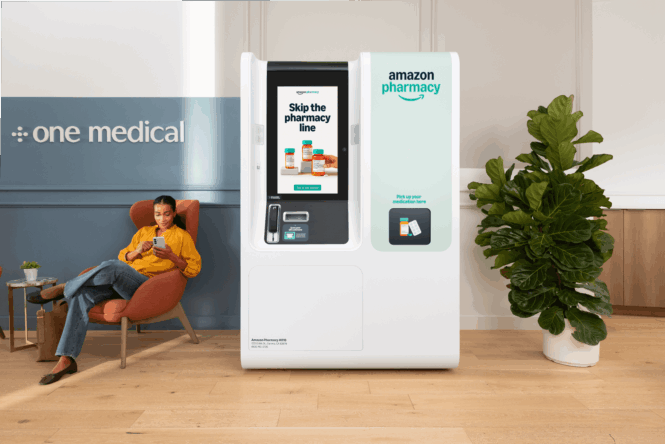
Amazon Pharmacy to launch electronic kiosks for prescriptions at One Medical locations
From Reuters — Amazon is launching electronic pharmacy kiosks at its One Medical locations in Los Angeles starting December 2025, allowing patients to immediately pick up common prescriptions like antibiotics and asthma inhalers right after their doctor visit, removing a major barrier to treatment and reducing the need for separate pharmacy trips.
What Are Amazon Pharmacy Kiosks?
These in-office kiosks, operated by Amazon Pharmacy, are positioned in One Medical facilities throughout greater Los Angeles, including Downtown LA, West LA, Beverly Hills, Long Beach, and West Hollywood. The kiosks will offer frequently prescribed medications, such as antibiotics, inhalers, blood pressure treatments, and seasonal remedies, but will not include refrigerated or tightly controlled medications.
How the Service Works
Patients can create an Amazon Pharmacy account, book an appointment at a participating One Medical office, and have their provider send their prescription to Amazon Pharmacy. During checkout in the Amazon app, users select kiosk pickup, pay, and receive a QR code to retrieve their medications within minutes. There is virtual access to pharmacists for consultation, just like at a regular pharmacy counter.
Impact and Expansion Plans
Amazon aims to broaden kiosk deployments beyond California by 2026, partnering with other health systems. The program seeks to address pharmacy deserts—areas lacking easy drug access—and improve adherence to prescriptions, as nearly one-third of prescriptions nationwide go unfilled due to logistical barriers. One Medical membership is not required to access the kiosk service; appointments and medication pickups are available to non-members as well.
Why Amazon Is Doing This
High shipping and delivery costs have tempered the profitability of Amazon’s mail-order pharmacy business. By placing kiosks where patients receive care, Amazon hopes to reduce those costs and raise demand, while boosting treatment initiation rates and improving overall patient health outcomes.
What Could Go Wrong?
Amazon’s new pharmacy kiosks in One Medical offices offer convenience for patients to get prescriptions filled immediately after appointments, but face operational and access challenges. Medcity did an analysis.
Good Points
-
The kiosks make it easier for patients to pick up common medications right after their doctor’s visit, removing the barrier of a second trip to the pharmacy, which could improve prescription fill rates.
-
Patients can view costs and pay through an app, see available discounts, and get insurance copays upfront, enhancing price transparency and convenience.
-
If patients have questions, they can access Amazon pharmacists by video or phone for real-time support at the kiosk or afterwards.
-
Experts think Amazon’s scale and resources may help the company succeed where others have failed in similar kiosk ventures.
Bad Points
-
The kiosks are only available at select urban and affluent One Medical locations, so the impact on underserved “pharmacy deserts” is limited and access for vulnerable populations remains a challenge.
-
Managing, powering, and maintaining the kiosks is expected to be very costly and complex, which could threaten operational success.
-
Privacy and cleanliness concerns persist, especially post-pandemic, as people may not want to touch machines for sensitive health needs and may prefer the privacy of a traditional pharmacy.
-
Previous companies with similar kiosk ideas have failed, raising doubts about whether the model can work at scale despite Amazon’s advantages.
-
For the model to succeed, kiosks need to be well-stocked, quick, easy to use, offer full prescription fills, and keep costs competitive—otherwise, patients may stick with traditional pharmacies.
-
There are real risks of abuse and concerns over patient behavior changes with machine-driven medication dispensing, requiring supervision and human support for safe operation.
Leading Examples of Automated Prescription Vending
-
Asteres ScriptCenter: One of the earliest and still most recognized systems, ScriptCenter machines have been used in hospitals, grocery stores, and military bases since the mid-2000s. They allow patients to pick up prescriptions securely after hours, requiring identity authentication and pharmacist approval before dispensing.
- As of January 2025, Asteres has deployed 1,000 ScriptCenter automated prescription kiosks across 38 U.S. states in locations such as retail pharmacies, hospitals, military bases, VA facilities, and employer groups.
-
InstyMeds: A Minnesota-based company providing automated medication dispensers often located in emergency departments and urgent care facilities. These machines dispense prepackaged prescriptions directly to patients after verification by a physician and remote pharmacist.
-
MedAvail SpotRx: MedAvail’s kiosks combine telepharmacy and dispensing, enabling remote pharmacist consultations via video along with automated drug release. They have been deployed in U.S. clinics and retail pharmacies, offering prescription and OTC medications with pharmacist oversight.
-
JVM MENITH: A South Korean automated drug dispensing machine launched in Europe in 2023, focusing on precise robotic dispensing and improved medication management processes in pharmacies and hospitals.
-
MTS Medication Technologies: A Florida-based firm specializing in large-scale automated medication dispensing systems for long-term care and institutional pharmacies. Acquired in mid-2025, it represents the expanding commercial interest in automated drug delivery technology.
Use Cases and Benefits
These machines are generally designed for:
-
Reducing wait times and after-hours pickup barriers.
-
Providing access to nonprescription and some prescription medications in controlled environments.
-
Supporting telepharmacy to connect patients with remote pharmacists.
While automation improves access and convenience, experts consistently highlight challenges such as limited formulary, patient education gaps, maintenance costs, and regulatory compliance concerns.

